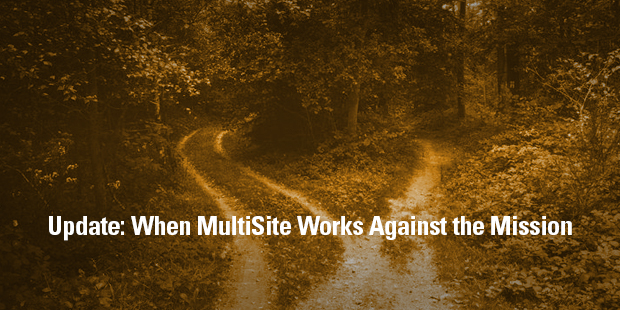
Update: When MultiSite Works Against the Mission
There have been many queries as to how things have been going at Meck since we made the strategic decision to end our multi-site approach in order to pursue other methods for ongoing growth and the pursuit of our mission to the unchurched.
You can read about that decision and our reasons for making it HERE.
I will confess that this update is not what I expected. I have been completely blindsided by it.
Since we have closed our sites, we’ve grown faster and become larger than at any other time in recent memory. I know, go figure. But from the very first weekend after closing our sites, our overall attendance has grown—and grown rapidly. We closed our sites at the end of May; currently, attendance in August 2019 is running 27% more than August 2018.
I have to reread that myself. We close multiple campuses, and grow by 27%, which for a church our size is stunning. We’re rushing to add services and fast-tracking building plans.
Why is this happening?
It’s early to venture too many conclusions, but here are a couple that seem apparent:
First, when you take the collective energies of a church and its staff and its volunteer base, and focus it on one site, it creates an incredible amount of energy. Think about light. Light that is diffused doesn’t make much of an impact, but focus that light through a magnifying glass and you can set something on fire. Focus it even more, and you have a laser than can cut through sheet metal.
Closing our sites has made us a laser.
Second, it was brisk reminder to all of us about the nature of our mission. A reminder that reaching out to our friends and family, neighbors and coworkers, is central to who we are. That we will make whatever decisions needed to reach our full redemptive potential. People at Meck knew why we closed the sites, what we were trying to achieve… and it renewed the fire within them for the mission and their participation with the mission.
So they’ve been inviting like never before because they were reminded – again – exactly what we are trying to collectively do as a Church. And just how much it matters.
These seem like intangibles, I know, but they are still very real. Yes, we have put fresh attention on all things digital, as we intended, but in truth that has yet to be fully realized. Yes, when you are focused on one campus, it makes for greater attention to detail from guest services to children’s ministry. Yes, the arts team is consolidated, allowing for its collective talents and energies to be invested in a single set of services.
All positive, all helpful, all productive. But the larger dynamic just seems to be renewed energy and focus and passion. It was such a pure missional decision, made from a position of already existing health and growth, that it poured even more fuel on the fire.
So our expected dip in attendance never came. The people we expected to lose by closing sites kept coming. From the very first weekend, we entered into the most accelerated growth stage in recent memory.
I was on a conference call with some other pastors who asked me about this, and when I told them what was happening, they said, “Wait until word gets out what’s happening at Meck—it’s going to make a lot of churches rethink things.” Another added, “It’s so hard to do multi-site—if we didn’t feel like we had to, I don’t think we would.”
I don’t want to say “Stop multi-site and you’ll grow.” I just know that it was true for us. And I will say that there are probably other churches just like us that would be served by rethinking their strategies, including the multi-site approach. Particularly if the only reason you are continuing to do it is because you fear you will decline (as we’ve proven that doesn’t have to be the case),
… or because you fear the optics of it.
On that last point, please don’t let that be your reason. I fear that many pastors and churches pursue the multi-site approach as a vanity project. They want to say they have multiple campuses, they want to appear large and successful, so they start sites. But for many, it’s a drain on their volunteer pool, their resources and more. It’s hurting more than it’s helping.
All to say, if vanity dictates your decision-making, you will make very bad decisions.
> Read more from James Emery White here.
















